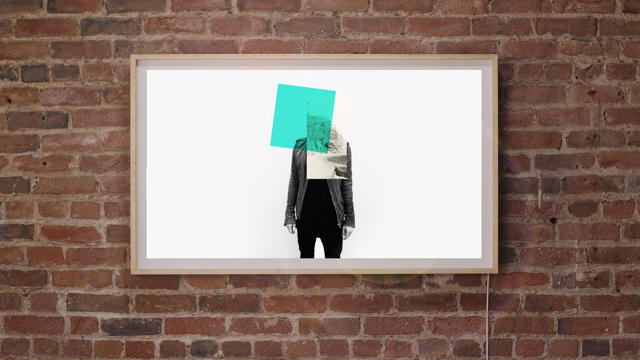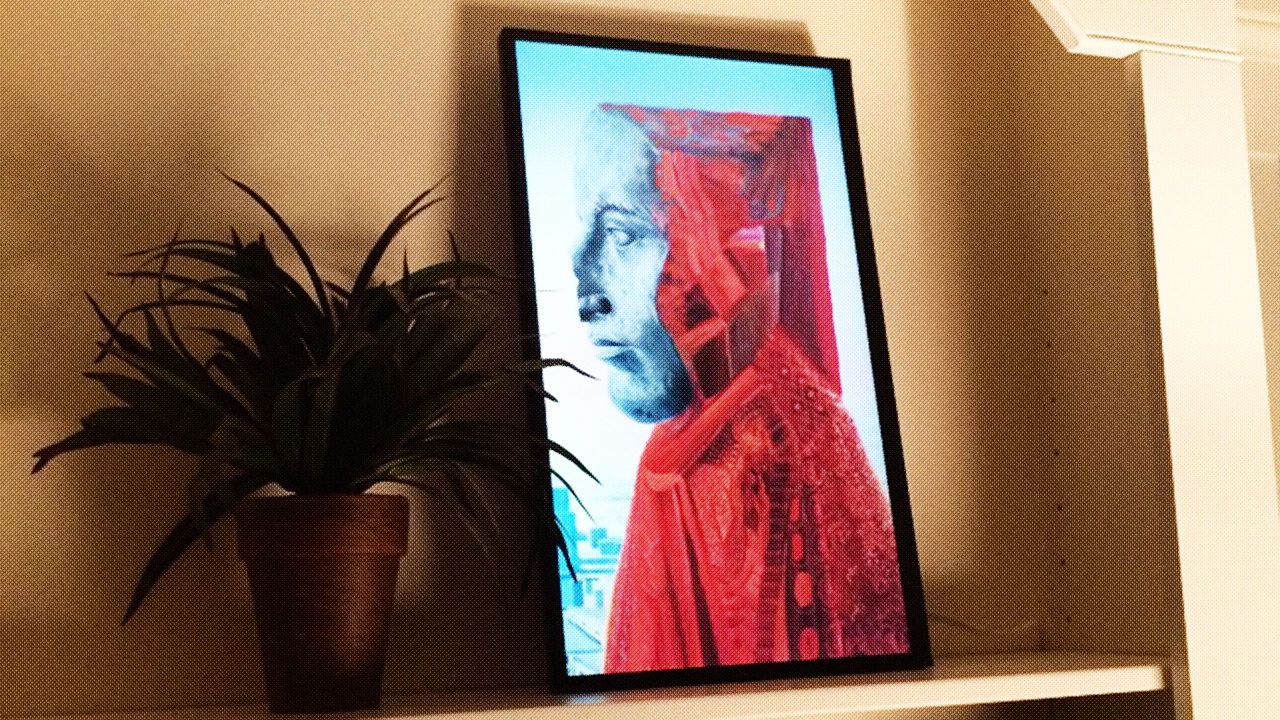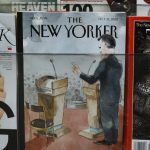For Digital Art, Watermarks Aim To Bring More Aura—And A Hotter Market
Anti-piracy technology lets media industries trace movies, music, and books across the Internet. Can it help the digital art market?
Thanks in no small part to the Internet, digital art is having a moment, and it’s attracting collectors too. An auction last year of GIFs, digital paintings, and printouts at Phillips in London raised over $113,000, including $3,500 paid for a website by the Dutch-Brazilian Internet artist Rafael Rozendaal.
Along with money, the budding market has also raised some interesting questions: If digital art is built on a medium prone toward reproduction, how do you make a one-of-a-kind edition? You might hang digital art on your wall, but how do you prove who made it, or that you bought it?
“Sharing art online is a double-edged sword,” says Shambhavi Kadam, a cofounder of Depict, a San Francisco-based startup that is building a physical, 4K Ultra HD picture frame, along with “watermarking” software to protect works bought and sold on its platform. An authentication system like this, she says, could give digital art resale value, and allow artists to track purchases and take a share of the profits, joining a global art market that reached a record $53 billion in sales last year. “Artists get a lot of exposure, but they aren’t able to claim ownership.”

In January, Depict raised $2.4 million for its product, which includes a platform for buying and displaying digital art at home. Along with it, an invisible digital “watermarking” system will certify and track limited digital editions, like certificates of authenticity for analog artwork, or digital rights management for digital music and e-books.
In Depict’s authentication system, each artwork—viewable on the company’s yet-to-be-released $1,800 Depict Frame, or through Chromecast or AppleTV—is associated with an owner, and tracked for when ownership is passed from one individual to another. Electric Objects, a New York startup also aiming to move digital art from the computer screen to the wall, has raised $1.7 million for its own digital art frame (available on pre-order for $399), but it is not pursuing digital watermarking or similar protection techniques.
Depict isn’t alone in its high-tech quest to prove originality and establish provenance for these pieces in their original 1s and 0s. Last year, entrepreneur Anil Dash and digital artist Kevin McCoy devised a way to link digital work to namecoins, data-storing cryptocurrencies that are derived from bitcoin. Because their strings of code are nearly impossible to forge, they can serve as virtual proofs of authenticity. Their program, Monegraph, is free for anyone to use, with one caveat: It costs one namecoin for each new creation or transaction. Today, that’s $0.50.
Depict proposes a similar approach, based on a technology that got its start in Hollywood: digital rights management. The premise is that no matter how the media file is copied, edited, compressed, or otherwise manipulated, an intentional marker remains in the bits that make up the work, allowing buyers and artists to verify and track each of the limited-edition pieces available for its frames.
How Digital Watermarking Works—And Doesn’t
The idea of media authentication initially gained popularity in the 1990s, with a less sophisticated technology that introduced a slight disturbance into the code beneath a file. For an image, that might mean flipping the last bit of data in every pixel. Or it might mean using digital signal processing algorithms to introduce noise into the image, while still remaining imperceptible to the human eye. Several companies have their own digital watermarking techniques and sell software to create them.
Outside of the art world, digital watermarking is well established in the movie and record industries. In 2005, a consortium of major Hollywood companies, like Disney, Warner Bros., and Sony agreed on an encryption standard that uses digital watermarking for movies released on Blu-ray. Now, Blu-ray players have to recognize the watermark before playing a disc.

But digital watermarking isn’t bulletproof. In the Blu-ray industry, one company is responsible for creating the technology. And a year after the Blu-ray anti-piracy standard came out, a hacker published all of the company’s encryption keys for Blu-rays on the Internet.
In principle, hackers who are well versed in signal processing can try to uncover a watermark by performing a digital transformation on a file’s data. Even if digital watermarks are designed to stay intact after certain kinds of manipulations, like compression, encoding, and cropping, they can still be susceptible to other exploits. (Depict says its technology is patent-pending).
In general, consumer pressure against data protection and privacy-prevention devices has halted these technologies’ use before. Digital rights management has been widely blamed for stifling innovation and competition and for limiting legitimate customers’ freedom to use their digital media; one study on the music industry has even found that removing DRM can actually increase sales. When Apple came out with its FairPlay DRM system in 2003, hackers started figuring out ways to circumvent the encryption. By 2007, Steve Jobs made a public statement, admitting FairPlay’s flaws. Apple subsequently negotiated DRM-free terms with major record labels. Since 2009, Apple has sold DRM-free music, but songs purchased before the change are still encrypted today.
In spite of the difficulties around watermarking music and films, Depict’s Kadam thinks watermarking will play a unique role in the digital art world because art traditionally appreciates in value over time. “That’s kind of cool: the idea of value appreciating in a digital edition is not something you think about with music or movies, but it’s certainly something that you can do with art when it’s presented like this,” she says. And such a system could promise a cut of sales to artists, who rarely earn revenue from secondary art markets.

Jake Levine, founder of Electric Objects, says the concept of a secondary market is foreign to all but an exclusive group of buyers and sellers. “We’ve conducted hundreds of interviews with users and artists over the past couple of years. In zero of those conversations has anyone asked for a feature that allows them to resell digital work on some kind of secondary market. It’s a vestige of an art world characterized by limited access, reproduction costs greater than zero, price opacity—in other words, all the things that the Internet is bad at,” Levine wrote in an email.
Some digital artists aren’t sure if there even is a reason to safeguard their work, seeing authentication as antithetical to the spirit of the medium. To Nick Briz, a digital artist who teaches a course on art piracy at the School of the Art Institute of Chicago, publishing on the Internet is a way of democratizing access to art, even if it’s defined as stealing in other contexts.
“Digital media should be free and copied,” the digital artist Evan Roth told the New York Times recently. A large acrylic print of his, depicting thumbprints on a touchscreen, sold for over $6,500 in London, but for fully digital works, he said, a copy-paste freedom reigns. “That’s its natural state. It’s like water flowing.”
Dan Perkel, an Ideo design researcher, wrote his PhD dissertation at Berkeley on the difference between sharing and stealing digital art. He explored what it means to create an infrastructure for digital artists on the web, using the popular digital art forum deviantART as his study’s cornerstone. He found that not every artist wants her work to go viral.
“A lot of the artists I talked to or observed online wanted to be open with different groups but somehow wanted that openness to not be extended to everyone. Or, they wanted to be open in order to connect with others and get feedback on their material, but that didn’t mean they wanted their work all over the Internet,” Perkel says.
According to Perkel, some digital artists set veiled boundaries on how openly they want their work shared on the Internet. It’s not all about gaining fame with everyone in the world but, rather, within certain pre-defined groups.
Digital watermarking technology could play a role here, helping artists figure out how and whether their work reaches specific audiences. The tech makes it possible to provide metrics, tracking each file and determining its location wherever it travels on the web—if not also helping digital artists access the market.
Jacob Ciocci, a New York-based artist who helped found the digital art collective Paper Rad, sees the watermarking idea as bringing some control to the chaos. “Digital watermarking is an interesting idea within what has, in the past 10 years, really been an unregulated ‘free for all’ of buying and selling of Internet/digital-based work,” Ciocci says.
But even with their ability to track and authenticate digital artwork, watermarks will need to win over artists and curators, not just buyers, he says.
“Art is about always questioning value within a contemporary context. And if a certain type of value is defined—watermarking—then another artist will always find a way to subvert that. It’s what art does really well,” says Ciocci.
Fast Company , Read Full Story
(145)














